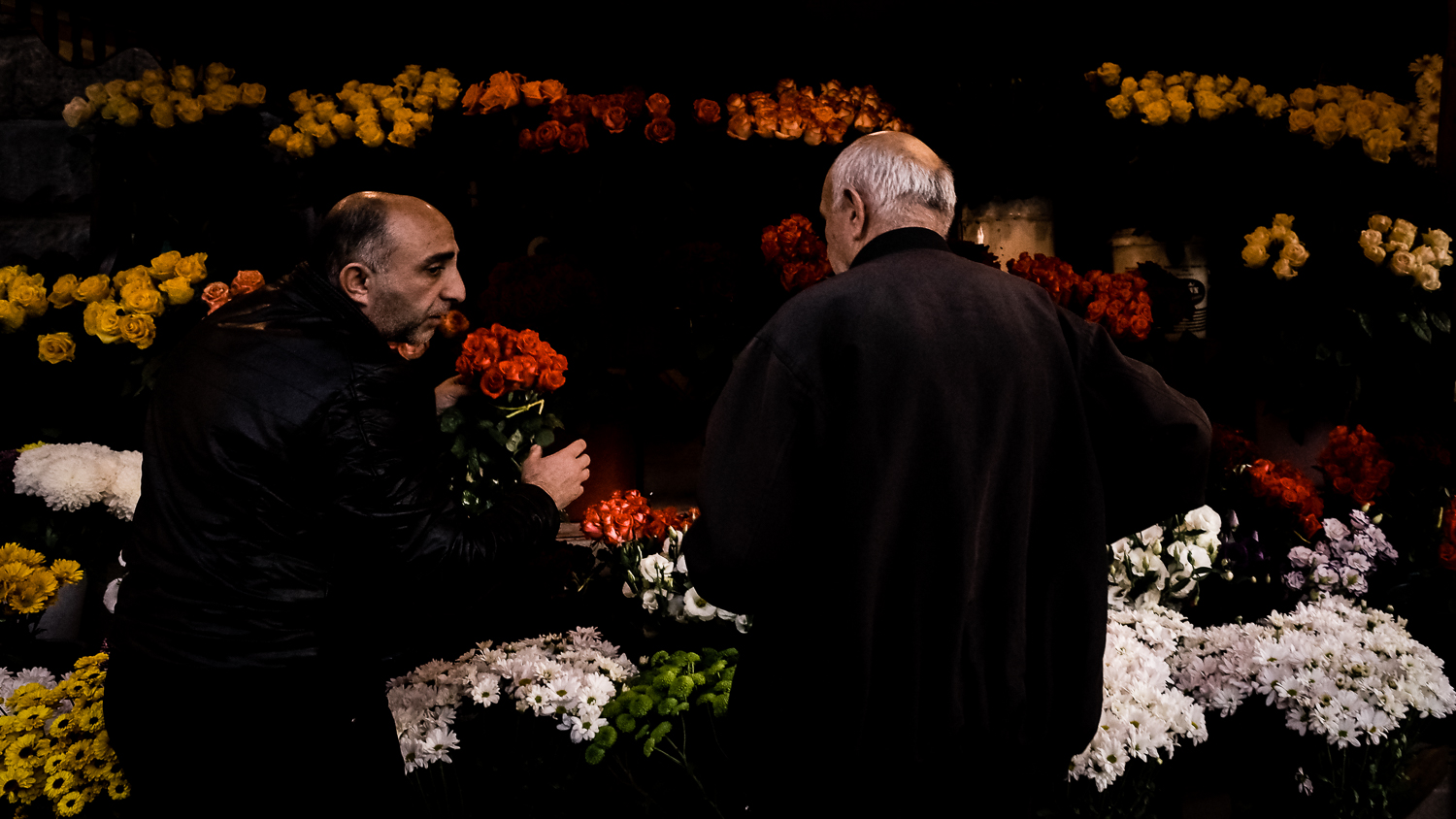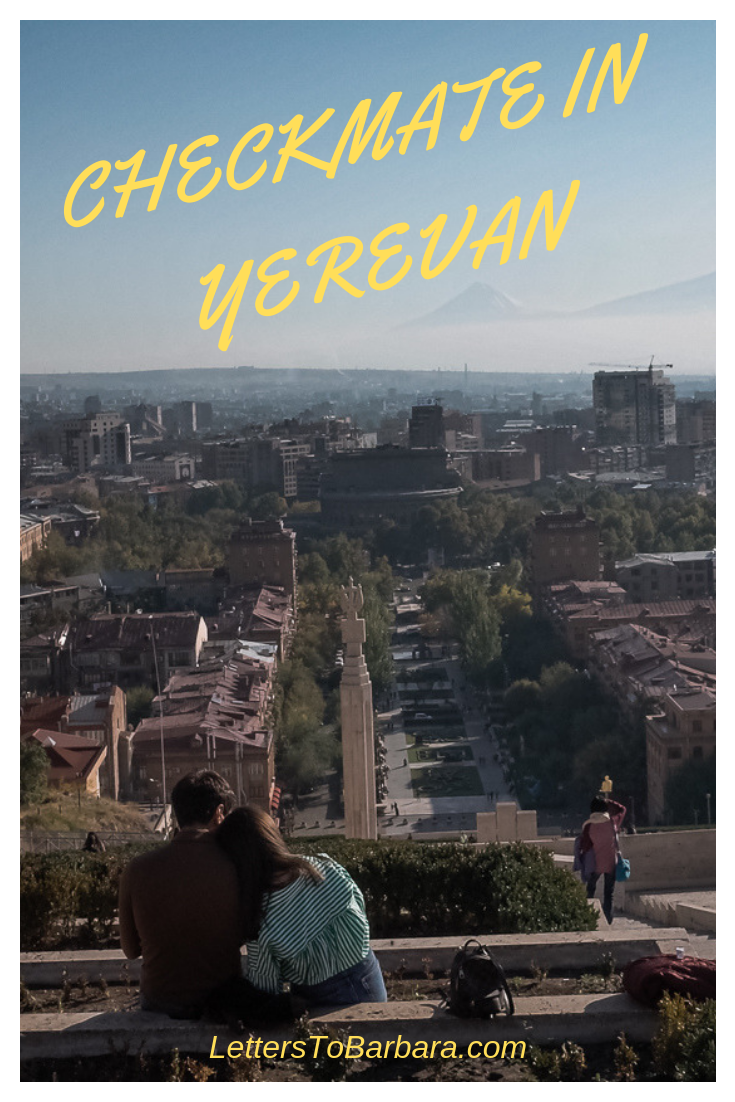Dear Barbara,
Yerevan has one of the most beautiful airports I’ve ever seen. Although I arrived very early in the morning (sleepless, as always), I was fascinated by the airport’s style: it’s elegant, compact and fits great into the scenery.
It was cold when I arrived, zero degrees. But this sounds to me normal: Yerevan’s altitude is 1,000 meters. I could, unfortunately, get only a glimpse of the landscape because I arrived shortly past sunrise. But what I’ve seen so far makes me glad to be here.
This is a landlocked country: there is no exit to the sea. But this is the country of the famous chess players and also, the place where Charles Aznavour is loved like a god. There are posters of him everywhere, there is a beautiful square dedicated to him, there is a house on the top of the hill that operates as a museum. There is quality music in Yerevan and there are loads of chessboards; people play chess literally everywhere.
And since I mentioned the people: they are all caring, open and smiling.
My Wes Anderson days in Yerevan

I arrive at the hotel very early in the morning. There is some sunlight in the sky but it hasn’t reached the city yet. Yerevan is about to wake up. I stand in front of the door and I ring the bell. No reply. I keep on ringing for like ten minutes but there is no reply at all. I decide to call. A sleepy guy takes the call.
“Hello?”
“Yeah, hi, I’m standing outside of the hotel for half an hour”. I exaggerate, of course, I guess I have a talent for that.
“Oh. Can you ring the bell, please?”
“I’ve been ringing like forever”.
“Oh. They might be in the toilet”.
The truth is, I must also go to the toilet urgently. The guy on the other end of the line hangs up and a couple of minutes later somebody appears on the front door. It’s a different voice from the one on the phone.
“I’m so sorry”, says the guy politely. “I don’t know what happened, I just realized that there is a blackout. Come on, I’ll show you your room and then I’ll take care of the problem”.
I feel like being on an island of darkness: the neighborhood is well lit but indeed, the hotel has no electricity. Everything is dark inside and I can barely find my way through the room. The sunrays need definitely an hour more before they reach the rooms. Oddly enough, electricity is interconnected with water. That said, there is also no water in the hotel.
And, of course, no breakfast can be served under such conditions, I assume. But I’m wrong. The guy knocks on my door and asks me to come to the breakfast room. I follow him along the dark stairway.
There is a chandelier on one table and soon my breakfast arrives. It looks good! The lady in the kitchen has used a vintage kerosene stove to cook an omelet for me. Plus, there is ham, cheese, lots of bread and jam. The guy takes the chandelier in hand and holds it close to me. We are both laughing and we start talking about Yerevan.
Yerevan is a sunny city

Yerevan has almost 300 days of sunshine per year. For a city on this longitude and latitude is way too much. Of course, being on an altitude of 1,000 meters also translates to a shorter circulation of the sun. But yet, this is not the problem: the thing is, that the city never seems to get enough sun. Even in the middle of the day, most of the streets remain shadowy.
One explanation can be the tall buildings. Again, for the size of Yerevan, the buildings seem to be insanely tall. There are buildings from the Soviet Union era but also new, contemporary premises. The people on the streets wear elegant clothes and there are many cafes all around the city. The atmosphere is lively, and the late autumn sun seems to make the locals joyful.
Squaring the circle (and circling the squares)

I always start exploring a city by walking its big avenues: I want to see the local life, I need to study the faces. Yerevan is no exception: there is a lot of traffic here, too. I end up in the Republic Square, a true architectural gem. The locals call it simply “The Square”. It has actually two sections: an oval roundabout and a more square-shaped one, which hosts a couple of musical fountains. There are five elegant buildings around the square: the Government House, the History Museum, the National Gallery, the Marriott Hotel and the ministries of Foreign Affairs and Transport and Communications.
And then, I take the Abovyan Street. This is another excellent example of Yerevan’s architecture and of course, I spend some time at the Charles Aznavour Square. I even take a couple of photos but for some reason, a policeman is paying way too much attention to me and I decide to leave. I have no idea why; it might be because of the kids playing around at this time of the day.
Then, I take a left turn further on up the road and I arrive at Freedom Square. This is another important square of Yerevan, described also as a symbol of democracy due to the protests that this place has seen. It hosts the Opera and it seems to be a local hangout. On one side, there is a small park with a pond in the middle and elderly citizens chitchat among kids running like there is no tomorrow.
I’m about to sit in one of the cafes when I realize that I forgot my wallet in the hotel. I have to walk back and since I feel very tired I wonder why do we even need money. It’s a silly question, but I haven’t slept for almost 36 hours and my mind is slowing down. At the entrance of the hotel, an old lady holds a basket full of apples. I tell her that I’m not really fond of apples but she insists. Then, she makes the global sign of money: she rubs her thumb and her pointer. And that’s why we, unfortunately, need money.
The Cascade Complex in Yerevan

One of the reasons I visited Yerevan, was because I wanted to see Mount Ararat. The best spot to do that is definitely the Cascade Complex. It is located just off the Freedom Square and this is an impressive outdoor museum, featuring sculptures plus a gigantic stairway. Fernando Botero has three or four sculptures there and the more you climb up the stairway, the more impressive Ararat looks.
To the top of the complex, there are approximately 500 stairs and it’s quite challenging to reach the end. I manage to do it (to my surprise) and every now and then I look back: Ararat appears like a spectacle out of this world. I first see the buildings of Yerevan and when the horizon seems to digest the capital of Armenia, I see a thick cloud. Above that cloud, Ararat appears gracious.
I can’t have enough of this view. I take loads of photos, maybe a hundred, and that’s not because I’m looking for the perfect shot. Not at all. I just want to have as many photos of this place as possible. When I’m finally at the top, I sit on the stairs and I stay there for quite a while. Although it would have been typical of me, as you know, to have deep and introverted thoughts, I don’t think of anything at all. I am dead tired and extremely happy at the same time. I look at Ararat which seems to be hanging above the clouds. Maybe Noah’s ark was a metaphor for Ararat, a mountain that seems ready to fly away.
Only Revolutions

There is optimism in the air of Yerevan. Earlier this year a revolution took place. In Armenia, they call it “The Velvet Revolution”. The people I talk to seem glad about it. They claim that there are visible traces that something starts slowly to change. Things move more quickly forward, the bureaucracy seems less. Together with the priceless kindness of the Armenians, the atmosphere all around the city is lively.
I see people playing chess in the parks. I’ve been told that chess is here part of school education. It seems to be a good time to visit Armenia. One of the chess players nods to me. He wants to know what I think of his country. I tell him that I’m impressed. He then says, “You know, Armenia is a welcoming country, it always was. But”, he continues, “there is always one sad thing here. Whenever there are disagreements, this nation can be divided in no time”. In Greece it’s the same, I tell him.
I leave the park and I walk towards the setting sun. Tomorrow I will hit the road for a long journey around the country. It is still warm in Yerevan and I stand in a corner of the Republic Square. I drink some fresh water from a pulpulak, the public water fountains that are so common here. The cold water comes straight from the mountains. It seems so refreshing, mainly because I imagine the way the water travels before it reaches this pulpulak. Of all the available metaphors about traveling, the flow of the water describes our journeys in the best possible way.
What a pity that you aren’t here with me.
Yours,
George
More about Armenia: Things to do in Armenia, Levon’s Divine Underground & The Stories of Armenia
Buy the camera I use | Book your hotel
Pin it!

Please share, tweet and pin if you enjoyed reading Checkmate in Yerevan. Your support keeps this website running and all the info up-to-date.
Last Updated on April 4, 2020 by George Pavlopoulos


Thanks for sharing your tour experience of Yerevan. Your pictures are saying everything. You had a great time in Yerevan.
Thank you very much for commenting 🙂 Yes, I really enjoyed Yerevan, it is such a fabulous city!